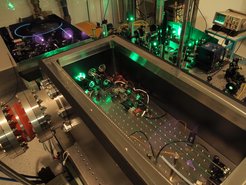XUV Frequency Comb
Frequency combs in the Extreme Ultraviolet (XUV)
Femtosecond laser optical frequency combs have revolutionized the measurement of optical frequencies and enabled optical atomic clocks. The same comb techniques are employed to control the carrier-envelope phase and thus the waveform of ultrafast laser pulses, which has led to the generation of single attosecond pulses. We hope that intracavity high harmonic generation (HHG) will open the door to another promising joint frontier of precision spectroscopy and ultrafast science. We are generating coherent radiation in the extreme ultraviolet (XUV) by high harmonic generation at the full oscillator repetition frequency of 10-100 MHz which is up to a 1000 times faster than previously possible with chirped pulse amplification or regenerative amplifiers. This high repetition rate causes the modes of the resulting XUV frequency comb to be well separated, allowing high resolution laser spectroscopy in this spectral region for the first time.
Intra-Cavity High Harmonic Generation (HHG)
We couple the pulses from a femtosecond mode-locked laser into a high finesse optical resonator that contains a Xenon gas jet at the cavity focus as the nonlinear medium. Inside this resonator, the pulse energy is enhanced so that it can drive the nonlinear process (HHG). For cw lasers, enhancement factors exceeding 100,000 have been reached and overall nonlinear conversion efficiencies approaching unity can be achieved. In the case of a mode-locked ultrafast laser, however, complying with the following extra requirements is more difficult: The output spectrum of a mode-locked laser does not contain just a single cw mode but a comb of such modes. An optical resonator for such radiation has to be simultaneously resonant for each mode. This can be accomplished with a resonator of appropriate length and zero group velocity dispersion (GVD). Thus far we have managed to extract microWatts of XUV power which could be sufficient to drive the 1S-2S transition in a hydrogen-like Helium ion with a reasonable rate (~1 Hz) provided that this power can be delivered and focused onto the ion which is difficult to do without significant losses.


Higher Conversion Efficiencies
Therefore, we are seeking methods that give rise to higher XUV output powers and/or higher conversion effciencies. The latter are typically on the order of 10-7 so that it is challenging to generate enough power in the XUV to drive interesting transistions such as the 1s-2s transition in He+. However, while the high harmonic cut-off, i.e. the shortest wavelength generated, scales with the driving laser as λ2, the power generated in the plateau harmonics is ~λ-6.3. One of our current projects therefore aims at exploiting this advantageous scaling feature of HHG by using a green driving laser instead of the usual infrared lasers to generate the required 60nm radiation.
Team
Current Members
Akira Ozawa, Johannes Weitenberg, Fabian Schmidt, Vignesh Vaidyanathan, Thomas Udem
Former Members
Andreas Vernaleken, Tobias Lamour, Peter Šušnjar, Christoph Gohle, Birgitta Bernhardt, Christian Speck
If you are considering joining our team as a Bachelor, Master or PhD student, or as a Postdoc,
please email to: Thomas Udem
Further Reading
A. Ozawa, J. Rauschenberger, Ch. Gohle, M. Herrmann, D.R. Walker, V. Pervak, A. Fernandez, R. Graf, A. Apolonski, R. Holzwarth, F. Krausz, T.W. Hänsch, and Th. Udem, High Harmonic Frequency Combs for High Resolution Spectroscopy, Physical Review Letters 100, 253901 (2008)
B. Bernhardt, A. Ozawa, A. Vernaleken, I. Pupeza, J. Kaster, Y. Kobayashi, R. Holzwarth, E. Fill, F. Krausz, T.W. Hänsch, Thomas Udem, Vacuum ultraviolet Frequency Combs generated by a femtosecond enhancement Cavity in the Visible, Optics Letters 37, 503 (2012)

